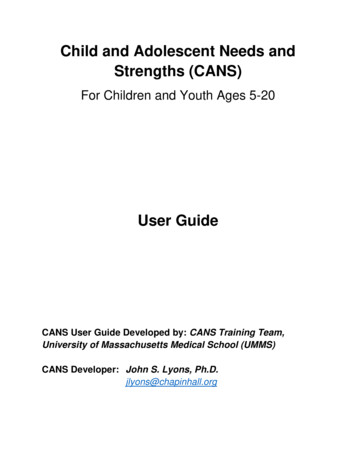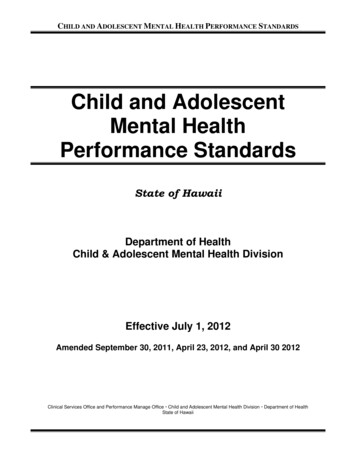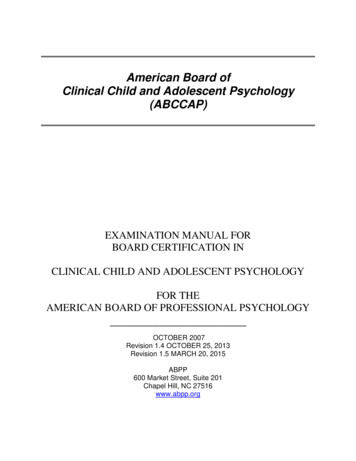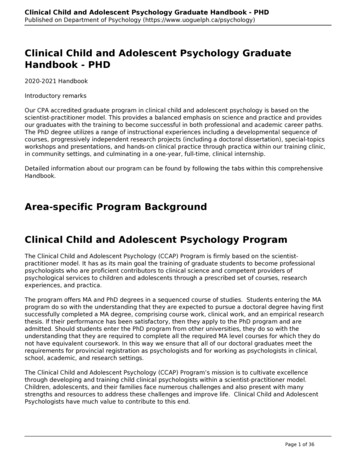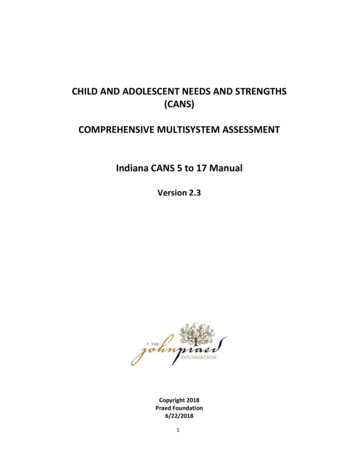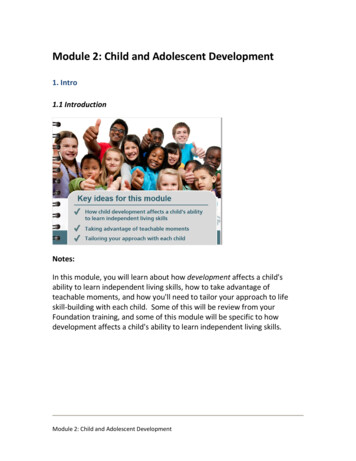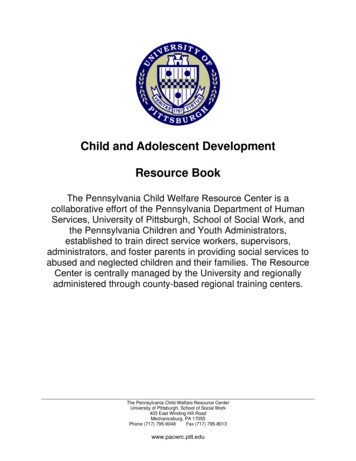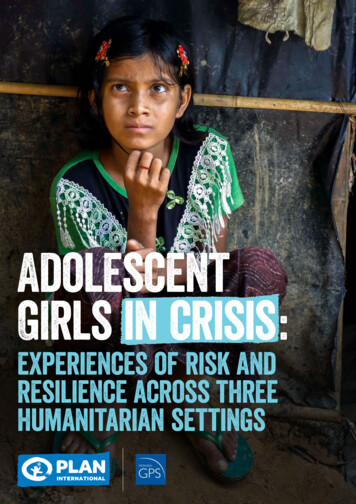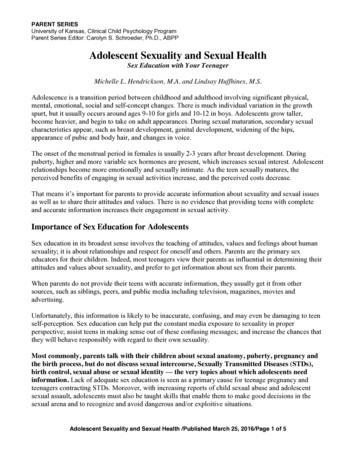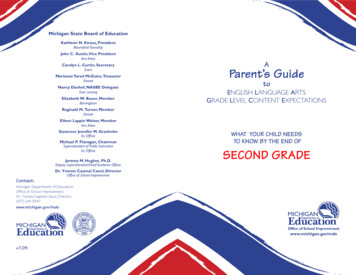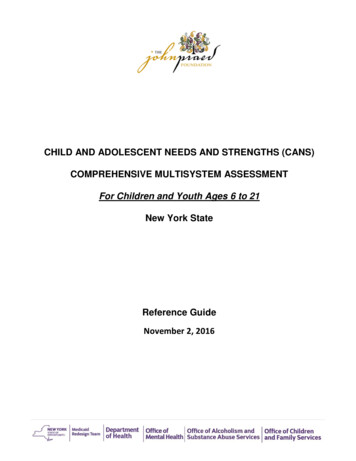
Transcription
CHILD AND ADOLESCENT NEEDS AND STRENGTHS (CANS)COMPREHENSIVE MULTISYSTEM ASSESSMENTFor Children and Youth Ages 6 to 21New York StateReference GuideNovember 2, 2016
A large number of individuals from the New York State the Office of Children and Family Services, theOffice of Mental Health, the Office of Substance Abuse Services, the Department of Health, and dozensof community agencies have collaborated in the development of the CANS-New York 6-21. Thisinformation integration tool is designed to support individual case planning and the planning andevaluation of service systems. The CANS-New York 6-21 is an open domain tool for use in servicedelivery systems that address the health and well-being of children, adolescents and their families. Thecopyright is held by the Praed Foundation to ensure that it remains free to use. For specific permissionto use please contact the Foundation. For more information on the CANS-New York 6-21 assessmenttool contact:John S. Lyons, Ph.D.Senior Policy FellowChapin Hall at the University of Chicago1313 East 60th StreetChicago, IL 60637jlyons@chapinhall.orgPraed tion.orgFor questions about the New York implementation of the CANS-NY, please contact:CANSNY.MRTImplementation@health.ny.gov.
CANS-NYAGES 6 to 21VERSION: November 2, 2016INTRODUCTIONThe CANS is a multiple purpose information integration tool that is designed to be the output of anassessment process. The purpose of the CANS is to accurately represent the shared vision of the childserving system—child and families. As such, completion of the CANS is accomplished in order to allowfor the effective communication of this shared vision for use at all levels of the system. Since its primarypurpose is communication, the CANS is designed based on communication theory rather than thepsychometric theories that have influenced most measurement development. There are six keyprinciples of a communimetric measure that apply to understanding the CANS.SIX KEY PRINCIPLES OF THE CANS1. Items were selected because they are each relevant to service/treatment planning. An itemexists because it might lead you down a different pathway in terms of planning actions.2. Each item uses a 4-level rating system. Those levels are designed to translate immediately intoaction levels. Different action levels exist for needs and strengths. A description of the actionslevels can be found on the following page.3. Rating should describe the child/youth, not the child/youth in services. If an intervention ispresent that is masking a need but must stay in place, this should be factored into the ratingconsideration and would result in a rating of an “actionable” need (i.e. “2” or “3”).4. Culture and development should be considered prior to establishing the action levels. Culturalsensitivity involves considering whether cultural factors are influencing the expression of needsand strengths. Ratings should be completed considering the child/youth’s developmental and/orchronological age depending on the item. In other words, anger control is not relevant for a veryyoung child but would be for an older child or youth regardless of developmental age.Alternatively, school achievement should be considered within the framework of expectationsbased on the child/youth’s developmental age.5. The ratings are generally “agnostic as to etiology.” In other words, this is a descriptive tool. It isabout the “what” not the “why.” Only one item, Adjustment to Trauma, has any cause-effectjudgments.6. A 30-day window is used for ratings in order to make sure assessments stay “fresh” andrelevant to the child or youth’s present circumstances. However, the action levels can be usedto over-ride the 30-day rating period.i CANS-NY 6 to 21 Introduction
CANS-NYAGES 6 to 21VERSION: November 2, 2016ACTION LEVELS FOR “NEED” ITEMS0 – No Evidence of Need – This rating indicates that there is no reason to believe that a particularneed exists. Based on current assessment information there is no reason to assume this is a need. Forexample, “does Johnny smoke weed?” He says he doesn’t, his mother says he doesn’t, no one elsehas expressed any concern – does this mean Johnny is not smoking weed? NO, but we have noreason to believe that he does and we would certainly not refer him to programming for substancerelated problems.1 – Watchful Waiting/Prevention – This level of rating indicates that you need to keep an eye on thisarea or think about putting in place some preventive actions to make sure things do not get worse (e.g.a child/youth who has been suicidal in the past). We know that the best predictor of future behavior ispast behavior, and that such behavior may recur under stress, so we would want to keep an eye on itfrom a preventive point of view.2 – Action Needed – This level of rating implies that something must be done to address the identifiedneed. The need is sufficiently problematic, that it is interfering in the child/youth’s or family’s life in anotable way.3 – Immediate/Intensive Action Needed – This level rating indicates a need that requires immediateor intensive effort to address. Dangerous or disabling levels of needs are rated with this level. Achild/youth who is not attending school at all or an acutely suicidal youth would be rated with a “3” onthe relevant need.ACTION LEVELS FOR “STRENGTHS” ITEMS0 – Centerpiece Strength – This rating indicates a domain where strengths exist that can be used as acenterpiece for a strength-based plan. In other words, the strength-based plan can be organizedaround a specific strength in this area.1 – Useful Strength – This rating indicates a domain where strengths exist and can be included in astrength-based plan but not as a centerpiece of the plan.2 – Identified Strength – This rating indicates a domain where strengths have been identified but thatthey require significant strength building efforts before they can be effectively utilized in a strengthbased plan.3 – No Strength Identified – This rating indicates a domain in which efforts are needed in order toidentify potential strengths for strength building efforts.ii CANS-NY 6 to 21 Introduction
CANS-NYAGES 6 to 21VERSION: November 2, 2016GUIDANCE FOR COMPLETING THE CAREGIVER SECTION OF THE CANS (6-21)Identifying the appropriate adults to include in the Caregiver section of the CANS is extremely importantas it can affect the amount of care coordination and home-based services the child is eligible for, inaddition to being critical to developing a suitable care plan for the child and family.For children who live at home, any parents or parent substitutes with a significant role in thechild’s life are considered caregivers that need to be rated in the CANS. In addition to thebiological parent the child lives with, examples of parent substitutes or other “caregivers” mayinclude a biological parent who does not live with the child but shares custody, a step-parentwho does live with the child, or a grandparent who has custody of the child.If children are in the legal custody of their parent(s), but are temporarily living elsewhere(hospital, detention center, nursing home) then these children’s CANS would include theparent(s) in the Caregiver section.Other children and families have unique circumstances where it may not be obvious which parents,and/or parent substitutes, if any, should be included in the CANS. This section provides guidance onCaregiver selection in a variety of circumstances that you may encounter.For older youth who are not in foster care status, and who are not living with any parents orparent substitutes, there may be no identified caregiver. This category may include youth whohave run away or thrown out of home, and are living on their own, on the streets, or in ahomeless or runaway youth shelter, and there is no suitable adult involved in the youth’s life. Inthis instance the Caregiver section of the CANS will NOT be completed.For children in foster care, consider the child’s current residence and the child’s permanencygoal to help decide which parent or parent substitute needs to be included in the CaregiverSection.IF CHILD IS IN FOSTER CARECHILD’S RESIDENCEFoster HomeReunificationBoth Parent(s)and FosterParent(s)Congregate CareParent(s)Living IndependentlyParent(s)iii CANS-NY 6 to 21 IntroductionPERMANENCY GOALLive withAnother Planned LivingAdoptionRelativeArrangement (APLA)Pre-adoptiveRelative(s)Foster Parent(s) and, if stillparent(s) andand Fosterinvolved in child’s care, the/or ive(s)Parent or NoNo CaregiverCaregiverPre-adoptiveRelative(s)Parent or NoNo CaregiverCaregiver
CANS-NYAGES 6 to EGIVER STRENGTHS & NEEDSPhysical HealthDevelopmentalMental HealthSubstance UsePartner RelationshipCaregiver Adjustment to TraumaLegalAcculturation/LanguageCulture nResourcefulnessDecision-MakingParenting StressHousing SafetyResidential StabilityFinancial ResourcesSafety from OthersInformal SupportsCultural Differences within a FamilyTransportation of ChildKnowledge of ConditionCare/Treatment InvolvementKnowledge CongruenceFamily Relationship to the SystemP.1B.27282930313233343536373839CHILD STRENGTHSFamily of OriginFoster FamilySocial Relationships With PeersSocial Relationships With AdultsRelationship tenceResilience/Internal StrengthsTalents/InterestsCultural IdentitySpiritual/ReligiousP.71 TOCVERSION: November 2, 2016C.404142434445464748CHILD NEEDS & FUNCTIONINGLiving SituationAcculturation/LanguagePeer InteractionsDecision-Making/JudgmentSleepPhysical LimitationsDental NeedsRecreationalJuvenile Justice/LegalP.10D.4950515253SCHOOL/ACADEMIC FUNCTIONEducational PartnershipSchool BehaviorSchool AchievementSchool AttendanceLearning AbilityP.12E.545556575859606162636465RISK BEHAVIORSSuicide RiskSelf-Injurious BehaviorOther Self-HarmDanger to OthersFire SettingSexually Reactive BehaviorSexual AggressionDelinquent BehaviorBullyingRunawayProblematic Social BehaviorEating 283ADVERSE CHILDHOOD EXPERIENCES P.16Sexual AbusePhysical AbuseEmotional Abuse/NeglectNeglectWitness to Abuse of Another ChildMedical TraumaDomestic ViolenceCommunity ViolenceExploitationSchool ViolenceNatural or Manmade DisastersCriminal ActivityParental IncarcerationDisruptions in Caregiving/AttachmentDeath of a Loved OneSubstance ExposureSexual Orientation/Gender Identity or ExpressionBullied
CANS-NYG.AGES 6 to 2184858687888990/91SCREENING QUESTIONS FOR MODULESP.19Trauma SymptomsBehavioral HealthSubstance UseDevelopmentalMedical HealthSelf-Care Activities of Daily LivingTransition to Adulthood andIndependent Activities of Daily Living84.ABCDEFGTRAUMA SYMPTOMS MODULEP.21Traumatic ssociationAffective/Physiological Dysregulation85.ABCDEFGHIJBEHAVIORAL HEALTH epressionAnxietyOppositionalConductEmotional ControlAnger ControlAttachmentP.2486.ABCDSUBSTANCE USE MODULESeverity of UseDuration of UsePeer InfluencesStage of RecoveryP.2787.ABCDEFGDEVELOPMENTAL nicationDevelopmental DelaySensoryP.282 TOCVERSION: November 2, 201688.ABCDEFGHMEDICAL HEALTH MODULELife ThreateningChronicityDiagnostic ComplexityEmotional ResponseImpairment in FunctioningIntensity of TreatmentOrganizational ComplexityFamily Stress89.SELF-CARE ACTIVITIES OF DAILY FGHIJKL91.ABCDEFP.30TRANSITION TO ADULTHOOD MODULEP.35Knowledge of ConditionMedication AdherenceYouth InvolvementSelf-Care ManagementYouth Relationship to the SystemCareer AspirationsEmploymentLiving SkillsEducational AttainmentPrevocationalIntimate RelationshipsTransportationINDEPENDENT ACTIVITIES OF DAILYLIVING MODULEP.39Meal PreparationShoppingHouseworkMoney ManagementCommunication Device UseHousing Safety
Page 1CANS-NY 6 to 21A. CAREGIVER STRENGTHS & NEEDS The CANS score sheet for the caregiver domain has space to ratemultiple caregivers, if applicable. The score sheet has space to indicate the caregiver’s relationship to thechild, such as parent or foster parent.If the child lives in a foster boarding home, complete (at least) 2 caregiver sections – one for the fosterparent and one for the parent(s) from who the child was removed.If the child is freed for adoption, do not complete a caregiver section for the child’s parents.If the child has a permanency goal other than return home, complete a caregiver section on the intendedpermanency person (if identified).If the child lives in a congregate foster care setting, there will be no foster parent to rate. For childrenwhose permanency goal is APLA, no caregiver section should be completed. For children with other permanencygoals, rate the parent from whom the child was removed and/or a different permanency resource person.10123PHYSICAL HEALTH: This item describes the presence of any medical or physical challenges to caregiving.Caregiver is generally healthy.Caregiver is in recovery from medical/physical problems.Caregiver has medical/physical problems that interfere with capacity to parent.Caregiver has medical/physical problems that make it impossible to parent at this time.20123DEVELOPMENTAL: This item describes the presence of any developmental challenges to caregiving.Caregiver has no developmental needs.Caregiver has developmental challenges but they do not currently interfere with parenting.Caregiver has developmental challenges that interfere with the capacity to parent.Caregiver has severe developmental challenges that make it impossible to parent at this time.30123MENTAL HEALTH: This item describes the presence of any mental health challenges to caregiving.Caregiver has no mental health needs.Caregiver is in recovery from mental health difficulties.Caregiver has some mental health difficulties that interfere with the capacity to parent.Caregiver has mental health difficulties that make it impossible to parent at this time.4SUBSTANCE USE: This item describes the presence of any substance use that presents challenges tocaregiving.Caregiver has no substance use needs.Caregiver is in recovery from substance use difficulties.Caregiver has some substance use difficulties that interfere with capacity to parent.Caregiver has substance use difficulties that make it impossible to parent at this time.012350123NAPARTNER RELATIONSHIP: This item refers to the primary caregiver’s intimate relationship with anotheradult. If married, this refers to the primary caregiver’s husband or wife.Caregiver has a generally positive, partner relationship with another adult. This adult functions as amember of the family.Caregiver has a generally positive partner relationship with another adult. This adult does not function asa member of the family.Caregiver is currently involved in a negative, unhealthy relationship with another adult. This adult doesnot live with the caregiver and children (include recent break-ups here if the partner still has access to thehousehold or has contact with the children).Caregiver is currently involved in a negative, unhealthy relationship with another adult who is living withthe primary caregiver and children.Primary Caregiver does not have an adult partner relationship.CANS-NYAGES 6 to 21VERSION: November 2, 2016
Page 2CANS-NY 6 to 2160123CAREGIVER ADJUSTMENT TO TRAUMA: This item is used to describe a caregiver who is having difficultyadjusting to traumatic experiences or events defined as traumatic by the caregiver. Informed speculationabout why a person is displaying certain behavior, linking trauma and behavior, may be entertained.There is no evidence of problems associated with traumatic life events.There is a history or suspicion of mild problems associated with a traumatic life event(s), or the caregiveris making progress adapting to trauma, or the caregiver recently experienced a trauma where the impacton their wellbeing is not yet known.There is clear evidence of negative symptoms associated with a traumatic life event(s). The symptoms areinterfering with the caregiver’s functioning in at least one life domain or the caregiver has been diagnosedwith a trauma-related disorder.The caregiver has been diagnosed with PTSD or has an extensive history of trauma exposure and there isclear evidence of trauma symptoms (e.g., numbing, nightmares, anger, dissociation) that interfere withmultiple areas of functioning.70123LEGAL: This item describes the caregiver’s involvement in any legal system due to caregiver’s behavior.Caregiver has no known legal difficulties.Caregiver has a history of legal problems but is not currently involved with the legal system.Caregiver has some legal problems and is currently involved in the legal system.Caregiver has serious current or pending legal difficulties that place them at risk for incarceration orcaregiver is currently imprisoned.801ACCULTURATION/LANGUAGE: This item includes both spoken and sign language.Caregiver(s) speaks and understands English well.Care giver(s) speaks some English but potential communication problems exist due to limits on vocabularyor understanding of the nuances of the language.Caregiver(s) does not speak English. A translator or native language speaker is needed for successfulintervention and someone can be identified within natural supports (do not include children under 18years of age).Caregiver(s) does not speak English. A translator or native language speaker is needed for successfulintervention and no such individual is available from among natural supports.2390123100123CULTURE STRESS: Culture stress refers to experiences and feelings of discomfort or distress arising fromfriction (real or perceived) between an individual’s own cultural identity and the predominant culture inwhich the individual lives.No evidence of stress between caregiver’s cultural identify and current living situation.Some mild or occasional stress resulting from friction between the caregiver’s cultural identify and currentliving situation.Caregiver is experiencing cultural stress that is causing problems of functioning in at least one life domain.Caregiver needs to learn how to manage culture stress.Caregiver is experiencing a high level of cultural stress that is making functioning in any life domaindifficult under the present circumstances. Caregiver needs immediate plan to reduce culture stress.SELF-CARE/DAILY LIVING: This item describes the caregiver’s ability to provide for the basic needs (e.g.,shelter, food, and clothing) of self.The caregiver has the skills needed to complete the daily tasks required to care for self.The caregiver needs verbal prompting to complete the daily tasks required to care for self.The caregiver needs physical prompting to complete the daily tasks required to care for self.The caregiver is unable to complete some or all of the daily tasks required to care for self.CANS-NYAGES 6 to 21VERSION: November 2, 2016
Page 3CANS-NY 6 to 21110123120123130123140123150123ORGANIZATION: This item describes the ability of the caregiver to organize and manage everydayresponsibilities, including the household duties, as well as caregiver’s and children’s appointments andactivities.Caregiver is well organized and efficient and the household runs smoothly.Caregiver has minimal difficulties with organizing and maintaining a household that supports children’sneeds or services.Caregiver has moderate difficulty organizing and maintaining a household that supports children’s needsor services.Caregiver is unable to organize a household that supports children’s needs or services.SUPERVISION: This item describes the caregivers’ ability to monitor and discipline the child in all the waysthat are required.Caregiver has good monitoring and discipline skills.Caregiver provides generally adequate supervision; may need occasional help or technical assistance.Caregiver reports difficulties monitoring or disciplining child. Caregiver needs assistance to improvesupervision skills.Caregiver is unable to monitor or discipline the child. Caregiver requires immediate and continuingassistance. Child is at risk of harm due to absence of supervision.RESOURCEFULNESS: This item describes the caregiver’s ability to identify and use external resourcesnecessary to manage challenges faced by self or child.Caregiver is quite skilled at finding resources that are useful in achieving and maintaining safety and wellbeing for self and child.Caregiver has some skills in finding resources that are useful in achieving and maintaining safety and wellbeing for self and child, but sometimes requires assistance in identifying or accessing resources.Caregiver has limited skills finding resources that are useful in achieving and maintaining safety and wellbeing for self and child. Caregiver requires temporary assistance with identifying and accessing resources.Caregiver has no skills in finding resources that are useful in achieving and maintaining safety and wellbeing for self and child. Caregiver requires ongoing assistance with identifying and accessing resources.DECISION-MAKING: This item describes the caregiver’s ability to comprehend and anticipate theconsequences of decisions; to plan, implement, and monitor a course of action; and to judge and selfregulate behavior according to anticipated outcomes.The caregiver has no evidence of problems with decision-making.The caregiver has mild or occasional problems thinking through problems or situations but decisionmaking abilities do not interfere with caregiver’s functioning as a parent.The caregiver has moderate or frequent problems thinking through problems or situations and thisinterferes with their ability to function as a parent.The caregiver has severe problems with decision-making and judgment placing the child at risk.PARENTING STRESS: This item reflects the degree of stress or burden experienced by the caregiver as aresult of the needs of all children in the household, including target child.Caregiver is able to manage the stress of the child/children’s needs.Caregiver has some problems managing the stress of the child/children’s needs.Caregiver has notable problems managing the stress of the child/children’s needs. This stress interfereswith their capacity to give care.Caregiver is unable to manage the stress associated with the child/children’s needs. This stress preventscaregiver from parenting.CANS-NYAGES 6 to 21VERSION: November 2, 2016
Page 4CANS-NY 6 to 21160123170123180123190123200123HOUSING SAFETY: This item describes whether the caregiver’s current housing circumstances are safe andaccessible. Consider the child’s specific medical or physical challenges when rating this item.Current housing has no challenges with regard to fully supporting the child’s health, safety, and accessibility.Current housing has minor challenges with regard to fully supporting the child’s health, safety andaccessibility but these challenges do not currently interfere with functioning or present any notable risk tothe child or others.Current housing has notable limitations with regard to supporting the child’s health, safety, andaccessibility. These challenges interfere with or limit the child’s functioning.Current housing is unable to meet the child’s health, safety, and accessibility needs. Housing presents asignificant risk to the child’s health and well-being.RESIDENTIAL STABILITY: This item describes the housing stability of the caregiver.Caregiver has stable housing for the foreseeable future.Caregiver has relatively stable housing but either has moved in the past three months or there areindications of housing problems that might force them to move in the next three months.Caregiver has moved multiple times in the past year. Housing is unstable.Caregiver has experienced periods of homelessness in the past six months.FINANCIAL RESOURCES: This item refers to the income and other sources of money available to caregiversthat can be used to address family need.No evidence of financial issues or caregiver has financial resources necessary to meet needs.History or suspicion, or existence of mild difficulties. Caregiver has financial resources necessary to meetmost needs; however, some limitations exist.Moderate difficulties. Caregiver has financial difficulties that limit ability to meet significant family needs.Significant difficulties. Caregiver is experiencing financial hardship, poverty.SAFETY FROM OTHERS: This item describes the caregiver’s ability to ensure the child’s safety within thehome and community.Caregiver’s household is safe and secure from potentially dangerous individuals – no risk from others.Caregiver’s household is safe but concerns exist about the safety of the child due to history or others inthe neighborhood that might be abusive.Child is in some danger from one or more individuals with access to the household.Child is in immediate danger from one or more individuals with unsupervised access.INFORMAL SUPPORTS: This item refers to the caregiver’s relationship with extended family, friends, andneighbors who can provide emotional and instrumental support.The caregiver has adaptive relationships. Extended family members, friends or neighbors play a centralrole in the functioning and well-being of the caregiver and family. Caregiver has predominately positiverelationships and conflicts are resolved quickly.The caregiver’s relationships are mostly adaptive. Extended family members, friends, or neighbors play asupportive role in caregiver and family functioning. They generally have positive relationships. Conflictsmay linger but are eventually resolved.The caregiver has limited relationships. Extended family members, friends, or neighbors are marginallyinvolved in the functioning and well-being of the caregiver and family. The caregiver has generallystrained or absent relationships with these informal supports.The caregiver has significant difficulties with relationships. The caregiver is not in contact or estrangedfrom extended family members. They may report they have no friends or no contact with neighbors. Thefamily has negative relationships involving continuing conflicts with extended family and friends. Thefamily does not feel supported and may feel shunned by their neighbors.CANS-NYAGES 6 to 21VERSION: November 2, 2016
Page 5CANS-NY 6 to 21210123220123230123240123CULTURAL DIFFERENCES WITHIN A FAMILY: Sometimes individual members within a family have differentbackgrounds, values or perspectives. In many cases, this may not cause any difficulties in the family asthey are able to communicate about their differences, but for others it may cause conflict, stress, ordisengagement between family members and impact the child’s functioning. This might occur in a familywhere a child is adopted from a different race, culture, ethnicity, or socioeconomic status. The parent maystruggle to understand or lack awareness of the child’s experience of discrimination. Additionally this mayoccur in families where the parents are first generation immigrants to the United States. The child mayrefuse to adhere to certain cultural practices, choosing instead to participate more in popular U.S. culture.No evidence of conflict, stress, or disengagement within the family due to cultural differences or family isable to communicate effectively in this area.Child and family have struggled with cultural differences in the past, but are currently managing them wellor there are mild issues of disagreement.Child and family experience difficulties managing cultural differences within the family which negativelyimpacts the functioning of the child.Child and family experience such significant difficulty managing cultural differences within the family thatit interferes with the child’s functioning or requires immediate action.TRANSPORTATION OF CHILD: This item reflects the caregiver’s ability to provide appropriatetransportation for the child.Child and caregiver have no transportation needs. Caregiver is able to get child to appointments, school,activities, etc. consistently.Child and caregiver have occasional transportation needs for appointments. Caregiver has difficultygetting child to appointments, school, activities, etc. less than once a month.Child and caregiver have frequent transportation needs. Caregiver has difficulty getting child toappointments, school, activities, etc. regularly (e.g. once a week). Caregiver needs assistance transportingchild and access to transportation resources or may require a special vehicle.Child and caregiver have no access to appropriate transportation and are unable to get child toappointments, school, activities, etc. Caregiver needs immediate intervention and development oftransportation resources.KNOWLEDGE OF CONDITION: This item seeks to identify whether the caregiver requires more informationabout the child’s developmental, behavioral, or medical condition(s) in order to be the best advocate forthe child.Caregiver is knowledgeable about the child’s condition(s), needs and strengths.Caregiver is generally knowledgeable about the child but may require additional information to improvetheir parenting capacity.Caregiver has clear need for information to improve knowledge about the child. Current lack ofinformation is interfering with ability to parent.Caregiver’s lack of knowledge places the child at risk for significant negative outcomes.CARE/TREATMENT INVOLVEMENT: This item describes the degree to which the caregiver is involved inseeking and supporting care/treatment to address the needs of the child.Caregiver is actively involved in treatment and ensures that treatment is provided consistently orcaregiver is an effective advocate for child.Caregiver is open to
The CANS is a multiple purpose information integration tool that is designed to be the output of an assessment process. The purpose of the CANS is to accurately represent the shared vision of the child serving system—child and families. As such, completion of the CANS is accomplished in order to allow for the effective communication of this shared vision for use at all levels of the system.
